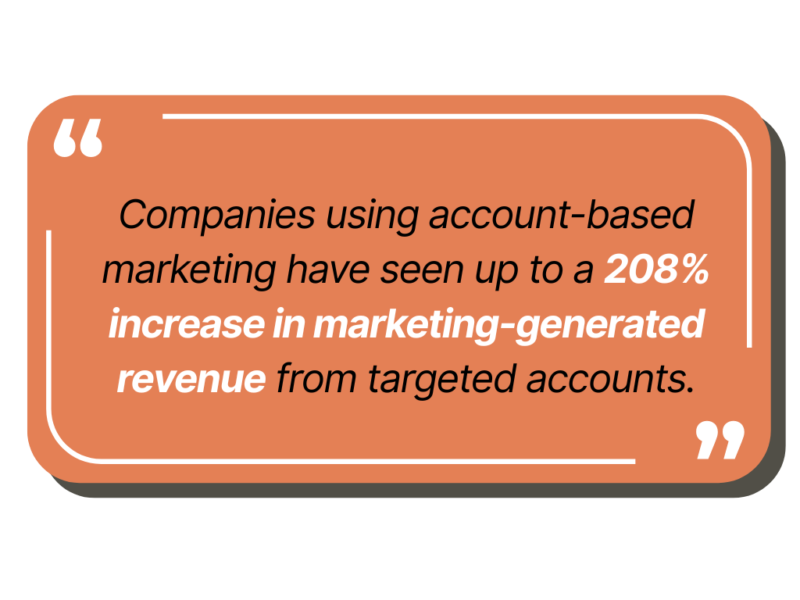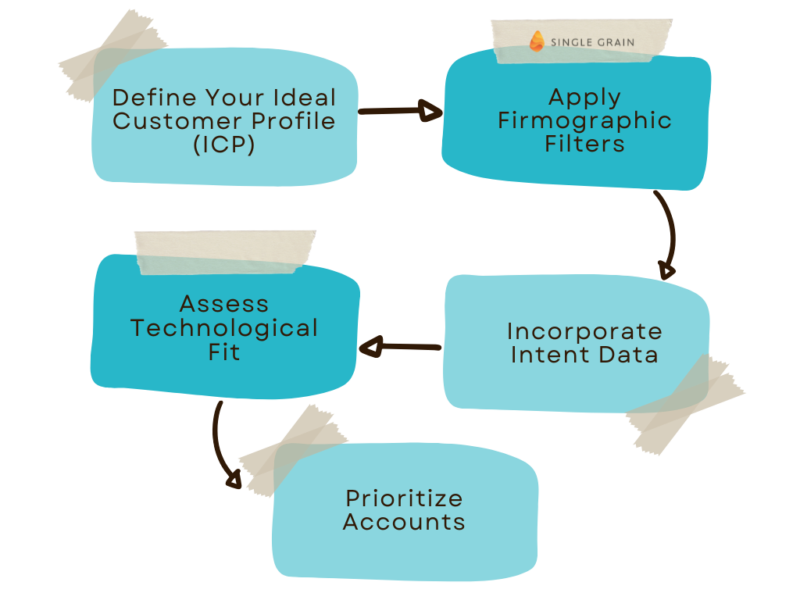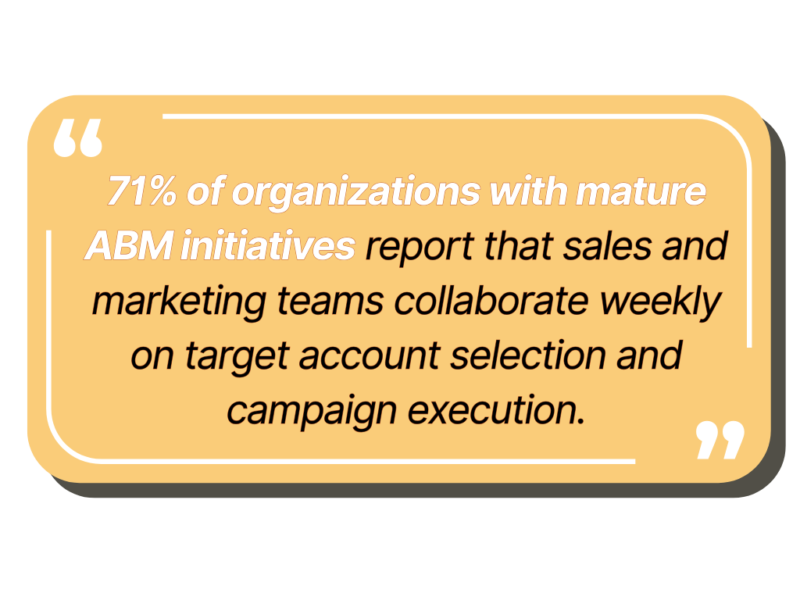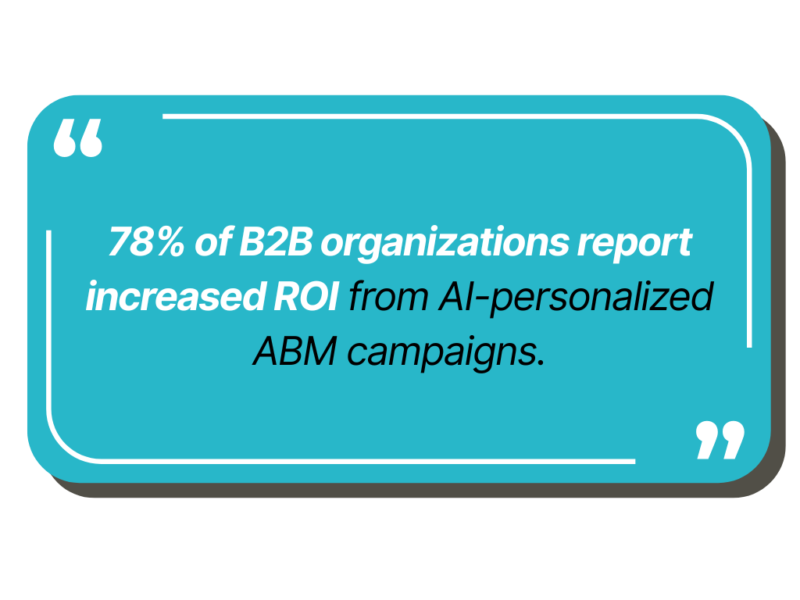70% of marketers now have active account-based marketing programs in place, marking ABM’s transformation from a niche tactic to a mainstream B2B strategy. This shift isn’t surprising when you consider the potential impact: companies implementing ABM have seen up to a 208% increase in marketing-generated revenue from targeted accounts. Whether you’re just getting started with account-based marketing or looking to optimize your existing program, this comprehensive ABM guide will equip you with practical strategies to identify high-value accounts, align your sales and marketing teams, and deploy personalized campaigns that drive measurable results.
In an era where personalization is paramount and marketing budgets face increasing scrutiny, ABM offers a focused approach that concentrates resources on accounts with the highest potential value. The result? Higher conversion rates, accelerated sales cycles, and stronger customer relationships that drive sustainable growth.
Key Takeaways
- ABM delivers significant revenue impact when implemented correctly, with companies seeing up to a 208% increase in marketing-generated revenue from targeted accounts.
- Sales and marketing alignment is critical for ABM success, with 71% of organizations with mature ABM initiatives reporting weekly collaboration between these teams on account selection and campaign execution.
- Effective ABM requires a 5-step approach including target account selection, sales-marketing alignment, personalized content creation, multi-channel engagement, and proper measurement of account-level metrics.
- Data-driven account selection is fundamental to any ABM guide implementation, with 78% of high-performing ABM teams using firmographic and intent data to select and prioritize target accounts.
- Advanced ABM tactics like AI-driven personalization are becoming essential, with 78% of B2B organizations reporting increased ROI from AI-personalized ABM campaigns.
TABLE OF CONTENTS:
What Is Account-Based Marketing?
Account-based marketing represents a strategic shift from traditional lead generation approaches. Rather than casting a wide net to capture as many leads as possible, ABM flips the funnel. It begins by first identifying specific high-value target accounts, then creating personalized campaigns designed to engage multiple stakeholders within those organizations.
At its core, ABM focuses on quality over quantity—focusing your marketing resources on the accounts most likely to convert and generate significant revenue. This targeted approach aligns marketing and sales efforts around the same goals and accounts, creating a unified strategy that addresses each target organization’s specific needs and pain points.
ABM vs. Traditional Marketing: Key Differences
| Traditional Marketing | Account-Based Marketing |
|---|---|
| Broad audience targeting | Focused on specific accounts |
| Generic messaging | Personalized content for each account |
| Lead-based metrics (quantity) | Account engagement metrics (quality) |
| Marketing to sales handoff | Aligned marketing and sales efforts |
| Campaign-focused | Account journey-focused |
Why ABM Works: The Data Behind Account-Based Marketing
The evidence supporting ABM’s effectiveness is compelling. Companies using account-based marketing have seen up to a 208% increase in marketing-generated revenue from targeted accounts. This isn’t just a statistical outlier—it reflects the fundamental advantage of focusing resources on accounts with the highest potential value.

When you examine successful ABM programs, several key factors contribute to these impressive results:
- Efficient resource allocation – By concentrating efforts on high-value accounts, marketing teams avoid wasting resources on prospects unlikely to convert
- Personalized engagement – Tailored messaging that addresses specific pain points resonates more deeply with target accounts
- Multi-stakeholder approach – ABM recognizes that B2B buying decisions involve multiple decision-makers and influencers
- Sales and marketing alignment – 71% of organizations with mature ABM initiatives report that sales and marketing teams collaborate weekly on target account selection and campaign execution
- Data-driven targeting – 78% of high-performing ABM teams use firmographic and intent data to select and prioritize target accounts
Building Your ABM Strategy: A Step-by-Step Guide
Developing an effective ABM strategy requires careful planning and execution. Let’s break down the key steps to create an ABM program that delivers measurable results.
Step 1: Target Account Selection and Segmentation
The foundation of any successful ABM program is identifying the right target accounts. While this may seem straightforward, effective account selection requires a data-driven approach:
- Define your Ideal Customer Profile (ICP) – Analyze your best existing customers to identify common characteristics such as industry, company size, technology stack, and business challenges
- Apply firmographic filters – Use criteria like annual revenue, employee count, geographic location, and industry vertical to build your initial list
- Incorporate intent data – Identify accounts actively researching solutions similar to yours through their online behavior and content consumption
- Assess technological fit – Consider whether a prospect’s current tech stack is compatible with your solution
- Prioritize accounts – Score potential accounts based on fit (alignment with your ICP) and intent (likelihood of making a purchase decision soon)
Remember that 78% of high-performing ABM teams use firmographic and intent data to select and prioritize target accounts. This data-driven approach ensures prioritizing the accounts most likely to convert.

Step 2: Align Sales and Marketing Teams
ABM success hinges on close collaboration between sales and marketing teams. This alignment must go beyond superficial agreement—it requires structured processes and shared accountability:
- Establish joint ownership – Create a dedicated ABM team with representatives from both sales and marketing
- Develop shared KPIs – Define metrics that matter to both teams, such as account engagement score, opportunity creation, pipeline velocity, and closed revenue
- Implement regular touchpoints – Schedule weekly meetings to review account progress and adjust tactics as needed
- Create collaborative workflows – Define clear processes for account selection, content creation, outreach coordination, and lead handoffs
- Use shared technologies – Implement tools that provide visibility across the entire account journey
This level of alignment isn’t just nice to have—it’s essential. Research shows that 71% of organizations with mature ABM initiatives report that sales and marketing teams collaborate weekly on target account selection and campaign execution.

Case Study: Designity
Challenge: Designity faced a significant disconnect between its sales and marketing teams, resulting in siloed operations, inconsistent messaging, and underperforming ABM campaigns.
Solution: They realigned their sales and marketing teams to work as a single unit, jointly identifying, engaging, and nurturing high-value target accounts with integrated account planning, shared KPIs, and regular alignment meetings.
Results: The approach led to higher conversion rates for targeted accounts, increased closed-won deals, and a more efficient sales process.
Key Takeaway: Aligning sales and marketing teams can transform ABM campaigns into high-performing, revenue-generating engines.
Step 3: Create Personalized Content and Campaigns
Personalization is the heart of effective ABM. Generic content simply won’t cut it when you’re trying to engage specific accounts with unique challenges and needs. Here’s how to develop content that resonates with your target accounts:
- Research account-specific pain points – Go beyond generic industry challenges to understand the specific issues facing each target account
- Map content to buying stages – Create materials tailored to different stages of the buying journey, from awareness to consideration to decision
- Address multiple stakeholders – Develop content that speaks to the different concerns of various roles within the target organization (e.g., technical evaluators vs. financial decision-makers)
- Customize existing assets – Adapt your core content with account-specific examples, data points, and solutions
- Create high-value personalized experiences – For top-tier accounts, develop completely customized assets like personalized microsites, custom research reports, or tailored ROI calculators
The level of personalization should correspond to the potential value of the account. While one-to-one personalization for every piece of content isn’t feasible, you can implement one-to-few personalization for account clusters with similar characteristics.
Step 4: Deploy Multi-Channel Engagement Tactics
Effective ABM requires coordinated outreach across multiple channels to engage different stakeholders within your target accounts. A well-orchestrated multi-channel approach might include:
- Targeted digital advertising – Use account-based advertising platforms to deliver personalized ads to specific companies
- Email campaigns – Send tailored email sequences to identified stakeholders
- Direct mail – For high-value accounts, physical mailers can cut through digital noise
- Social selling – Engage decision-makers through personalized LinkedIn outreach
- Executive events – Host exclusive roundtables or workshops for target account executives
- Website personalization – Customize your website experience based on the visitor’s company
When deploying LinkedIn campaigns as part of your multi-channel strategy, you need tools that can both personalize at scale and deliver measurable results. Personalize & scale your LinkedIn ABM ads with solutions that automate personalization while maintaining the human touch that makes ABM effective.
Step 5: Measure ABM Success: Key Metrics and Analytics
Effective measurement is crucial for optimizing your ABM program. Unlike traditional marketing which focuses primarily on lead volume, ABM metrics should reflect account-level engagement and progression:
- Account engagement score – Aggregate measure of how involved target accounts are with your content and outreach
- Coverage – Percentage of relevant stakeholders identified and engaged within each account
- Awareness – Increased web traffic and content consumption from target accounts
- Opportunity creation rate – Percentage of target accounts that convert to opportunities
- Pipeline velocity – Speed at which target accounts move through the sales process
- Win rate – Percentage of target account opportunities that result in closed business
- Average contract value – Deal size from ABM-targeted accounts compared to non-ABM accounts
- Return on investment – Revenue generated compared to ABM program costs
For a more in-depth look at measuring ABM success, check out our 10 account-based marketing best practices for maximizing ROI, which includes detailed guidance on establishing the right measurement framework.
Advanced ABM Tactics for 2025
AI-Driven ABM Personalization
Artificial intelligence is revolutionizing ABM by enabling deeper personalization at scale. Research shows that 78% of B2B organizations report increased ROI from AI-personalized ABM campaigns. Here’s how leading companies are leveraging AI in their ABM programs:
- Predictive account selection – AI algorithms can identify accounts with the highest propensity to buy based on firmographic data, behavioral signals, and similarity to your best customers
- Dynamic content personalization – AI can automatically tailor content elements based on the viewer’s role, industry, and stage in the buying journey
- Next-best-action recommendations – AI can suggest the optimal next step for each account based on their engagement history
- Conversation intelligence – Natural language processing can analyze sales calls to identify common objections and successful messaging approaches
- Automated outreach optimization – AI can determine the best time, channel, and message for each contact within target accounts

Case Study: RollWorks
Challenge: RollWorks faced challenges breaking into large enterprise accounts and overcoming misaligned marketing and sales efforts, which resulted in long sales cycles.
Solution: They deployed a data-centric ABM program focusing on hyper-targeting high-value accounts with personalized content, advanced analytics, and real-time campaign optimization.
Results: The program drove a 33% year-over-year revenue increase, shortened the sales cycle by 22%, and resulted in a 3x increase in target account engagement.
Key Takeaway: A data-driven ABM strategy can significantly boost revenue and accelerate the sales cycle.
Leveraging Intent Data for Targeting
Intent data has become a critical component of advanced ABM strategies. By analyzing online behavior, intent data helps identify accounts actively researching solutions like yours—often before they’ve reached out to vendors. Here’s how to effectively leverage intent data:
- Identify active buyers – Focus on accounts showing research behavior related to your solution categories
- Understand research topics – Learn which specific aspects of your solutions potential buyers are investigating
- Time your outreach – Engage accounts when they’re actively researching rather than cold outreach
- Personalize based on interests – Tailor content to address the specific topics they’re researching
- Monitor competitive research – Identify accounts looking at your competitors and develop targeted competitive messaging
The most sophisticated ABM programs combine first-party intent data (from your own digital properties) with third-party intent data (from publisher networks and research sites) to create a comprehensive view of account interest.
Account Expansion Strategies
While many marketers focus ABM efforts on new account acquisition, applying ABM principles to existing customer expansion can yield even higher ROI. Account expansion strategies include:
- Identifying upsell opportunities – Use product usage data to spot accounts that could benefit from additional features or services
- Cross-sell mapping – Analyze customer data to identify accounts likely to benefit from complementary products
- Renewal campaigns – Create personalized retention programs for high-value accounts approaching renewal
- Customer marketing programs – Develop targeted content that showcases new use cases and capabilities
- Executive relationship building – Cultivate C-suite connections through exclusive events and thought leadership
For a comprehensive approach to account-based marketing that spans the entire customer lifecycle, explore our detailed account-based marketing (ABM) mega guide, which covers both acquisition and expansion strategies.
Common ABM Challenges and Solutions
Even well-designed ABM programs face obstacles. Here are the most common challenges and practical solutions:
| Challenge | Solution |
|---|---|
| Poor data quality | Invest in data enrichment tools and implement regular data hygiene processes |
| Sales-marketing misalignment | Create shared goals, metrics, and account plans with clear accountability |
| Content scalability | Develop modular content with customizable elements rather than creating everything from scratch |
| Attribution difficulties | Implement account-based attribution models that track the entire account journey |
| Technology gaps | Build an integrated ABM tech stack with purpose-built tools for targeting, engagement, and measurement |
For many organizations, selecting the right tools is a critical success factor. To help navigate the complex landscape of ABM technologies, refer to our guide on top ABM tools to enhance your account-based strategy.
Taking Your ABM Strategy to the Next Level
Account-based marketing represents a fundamental shift in how B2B organizations approach their highest-value opportunities. By focusing resources on specific target accounts, aligning sales and marketing efforts, and delivering personalized experiences, ABM delivers measurable business impact—from shortened sales cycles to increased deal sizes and improved win rates.
As you implement the strategies outlined in this ABM guide, remember that success doesn’t happen overnight. Start with a pilot program targeting a small number of accounts, measure results carefully, and refine your approach based on what works. Over time, you can scale your program to include more accounts and more sophisticated tactics.
The most successful ABM practitioners continually evolve their strategies, embracing new technologies like AI-driven personalization while staying focused on the fundamental principle that drives all effective ABM: delivering relevant, valuable experiences to the specific accounts that matter most to your business.
Ready to take your ABM strategy to the next level? Start by auditing your current approach against the framework outlined in this guide, identify your biggest opportunity areas, and develop a prioritized roadmap for improvement. Whether you’re just beginning your ABM journey or looking to optimize an existing program, the principles and tactics in this guide will help you achieve breakthrough results.
Related Video
www.singlegrain.com (Article Sourced Website)
#Complete #ABM #Guide #10X #Results #Strategic #AccountBased #Marketing
